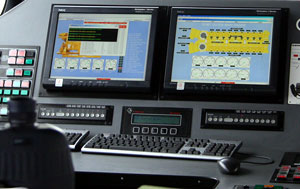
Posted by John Keller
New initiatives to equip U.S. surface warships with the latest computer and networking equipment clearly indicate that the U.S. Navy not only is starting to understand the notions of open systems and industry standards, but also is starting to get serious about this innovative way of procurement.
Perhaps the most important indicator is the Navy's Consolidated Afloat Network Enterprise System -- otherwise known as CANES -- which seeks to alter the Navy's currently unaffordable path of legacy applications and network acquisition in efforts to improve command, control, communications, computers, surveillance, and reconnaissance (C4ISR) capability.
Navy experts say they eventually would like to see a single suite of survivable common hardware able to host a wide variety of near-real-time combat support applications as they move forward with the CANES Common Computing Environment (CCE) network.
In addition, Navy leaders expect the CANES program to fall into line with commercial business information technology (IT) trends and move away from the traditional U.S. Defense Department integrated hardware and software stack legacy systems.
To my eye, this means that Navy technology experts plan -- often for the first time -- to follow trends in commercial industry IT trends rather than to specify the service's own unique computer and network architectures and standards. This may not sound like a big deal, but actually it's huge.
The Navy has a long history of unique, closed-system computer architectures going back to the shipboard UYK computers and airborne AYK computers. These systems -- although they often were adequate for their assigned tasks -- fell hopelessly behind the computing state of the art, and were difficult to upgrade.
Years ago the Navy tried to move toward open systems and industry standards with the Next Generation Computer Resources (NGCR) program, which sought to pick the best of industry standards and computer architectures. NGCR did not have a lasting big influence because it was not flexible enough to incorporate evolving technologies.
The CANES program, for which industry teams are forming now for a future series of competitions, sounds fundamentally different. It's a signal that the Navy will become a technology follower rather than application-specific developer, and will have the best shot it has ever had in crafting computer and network architectures that are easily maintained and able to accept rapid and frequent technology insertion and refresh.
This article makes several assertions that I find, well, just wrong. One, is that the Navy will become a technology "follower." Just wrong, the Navy and Marine Corps are always on the leading edge of what can be done better for our "war" business. What we envision as leaders of technology influences the industry. Secondly, don't sell the effort to go "open" systems so short. It was only until relatively a short time (in acquisition time) that we could take off the shelf components rugged and powerful enough for ships and field operations that allows us to become open systems procurers.
ReplyDeleteThe navy Next generation program was established not only to select the most appropriate standard but rather to influence the development of that standard, ensuring the navy’s unique requirements were represented. The program highlighted the Navy’s technical leadership rather than establishing it as a follower.
ReplyDeleteBest
Frank